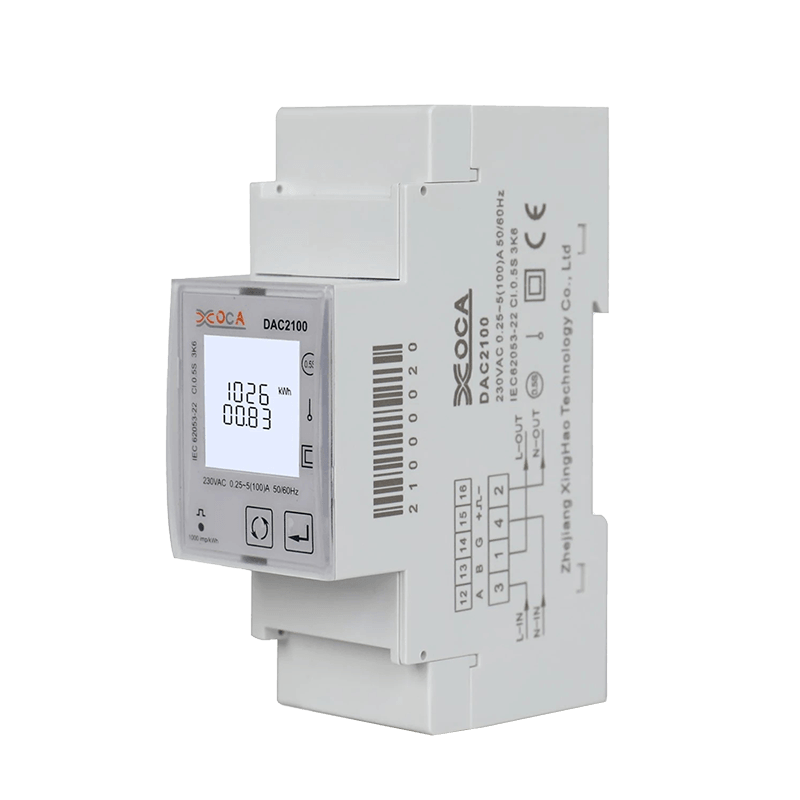What Is a Single Phase Power Meter and How Does It Work?
A single phase power meter is an essential device for measuring electrical energy consumption in single-phase AC systems. These meters are widely used in residential applications, small businesses, and light commercial settings where the electrical load doesn't require three-phase power. Unlike three-phase meters that handle more complex power systems, single phase power meters provide a simpler solution for basic energy monitoring needs.
Dac2100 DIN Rail Single Phase Smart Modbus Power Meter
Key Components and Their Functions
- Voltage Sensor: Measures the potential difference in the circuit (typically 120V or 230V depending on region)
- Current Sensor: Detects the current flow through the conductor (usually via current transformers)
- Processing Unit: Calculates power consumption using the formula P = V × I × PF (where PF is power factor)
- Display Interface: Shows kWh consumption and other parameters through LCD or mechanical counters
- Communication Module: In smart meters, enables data transmission to utility providers
Working Principle Explained
The fundamental operation of a single phase power meter involves continuous measurement of instantaneous voltage and current values. These measurements are multiplied to determine apparent power, which is then adjusted by the power factor to calculate real power consumption. The meter integrates this real power over time to determine total energy usage in kilowatt-hours (kWh).
How to Choose the Best Single Phase Energy Meter for Your Needs
Selecting the right single phase energy meter requires careful consideration of several technical specifications and application requirements. The best meter for your situation depends on factors like accuracy needs, load capacity, and additional features required.
Key Selection Criteria
- Accuracy Class: Typically ranges from Class 0.2 (high precision) to Class 2.0 (standard)
- Current Rating: Should match your maximum expected load (common ranges: 5-60A, 10-100A)
- Voltage Rating: Must match your supply voltage (120V, 230V, etc.)
- Communication Options: Basic pulse output, RS-485, Modbus, or wireless protocols
- Additional Features: Power quality monitoring, load profiling, tamper detection
Comparison of Meter Types
| Feature | Electromechanical | Electronic | Smart Meter |
|---|---|---|---|
| Accuracy | ±2% | ±1% | ±0.5-1% |
| Lifespan | 15-20 years | 10-15 years | 10-15 years |
| Additional Features | Basic measurement | Time-of-use tracking | Remote monitoring, advanced analytics |
Single Phase kWh Meter Installation Guidelines and Best Practices
Proper single phase kWh meter installation is crucial for accurate measurements and system safety. While utility companies typically handle primary meter installations, understanding the process is valuable for secondary metering applications or when adding sub-meters.
Installation Steps
- Safety First: Ensure power is disconnected before beginning installation
- Mounting: Secure the meter on a clean, vertical surface in a protected location
- Wiring: Connect live and neutral wires to designated terminals (refer to manufacturer diagram)
- Sealing: Apply tamper-proof seals if required by regulations
- Testing: Verify proper operation with known loads before finalizing installation
Common Installation Mistakes to Avoid
- Incorrect CT polarity (if using current transformers)
- Improper voltage reference connections
- Over-tightening terminal screws damaging conductors
- Installing in environments with excessive vibration or temperature extremes
- Failing to maintain proper clearances around the meter
Single Phase Smart Meter Benefits and Advanced Features
Modern single phase smart meters offer significant advantages over traditional electromechanical meters, transforming how consumers and utilities monitor and manage energy usage.
Key Advantages of Smart Meters
- Real-time Monitoring: Provides instant visibility into energy consumption patterns
- Automated Meter Reading: Eliminates manual readings and estimated bills
- Time-of-Use Tracking: Enables variable pricing based on consumption periods
- Remote Connectivity: Allows for remote disconnection/reconnection and firmware updates
- Power Quality Monitoring: Detects voltage sags, swells, and harmonics
Advanced Smart Meter Capabilities
Beyond basic energy measurement, contemporary single phase smart meters often include:
- Tamper detection algorithms identifying unauthorized access
- Load profiling for appliance-level energy monitoring
- Integration with home automation systems
- Prepaid electricity functionality
- Grid management support through demand response programs
Single Phase vs Three Phase Power Meter: Understanding the Differences
When comparing single phase vs three phase power meter solutions, several technical and practical differences become apparent. The choice between them depends primarily on the electrical system's configuration and power requirements.
Technical Comparison
| Parameter | Single Phase Meter | Three Phase Meter |
|---|---|---|
| Number of Conductors | 2 (L+N) | 3 or 4 (3L+N) |
| Typical Applications | Residential, small commercial | Industrial, large commercial |
| Power Delivery | Pulsating | Continuous |
| Efficiency | Lower for heavy loads | Higher for balanced loads |
When to Choose Each Type
Single phase power meters are appropriate when:
- Total load is below 10kW (varies by region)
- Only basic appliances are used (lights, refrigerators, etc.)
- The electrical system is simple with no heavy machinery
Three phase meters become necessary when:
- Load exceeds single phase capacity
- Operating heavy motors or industrial equipment
- Requiring more stable power delivery
Single Phase Electricity Meter Calibration and Maintenance
Regular single phase electricity meter calibration ensures measurement accuracy and compliance with regulatory standards. Proper maintenance extends meter lifespan and prevents measurement errors.
Calibration Procedures
- Reference Standards: Comparison against certified reference meters
- Test Points: Verification at multiple load points (10%, 50%, 100% of rated current)
- Power Factor Tests: Checking accuracy at different PF values (1.0, 0.5 lagging)
- Temperature Tests: Ensuring performance across operating temperature range
Maintenance Best Practices
- Periodic visual inspections for physical damage
- Cleaning of meter surfaces and display windows
- Verification of terminal tightness (after power disconnection)
- Monitoring for unusual consumption patterns indicating potential issues
- Scheduled recalibration based on manufacturer recommendations


 English
English 中文简体
中文简体







